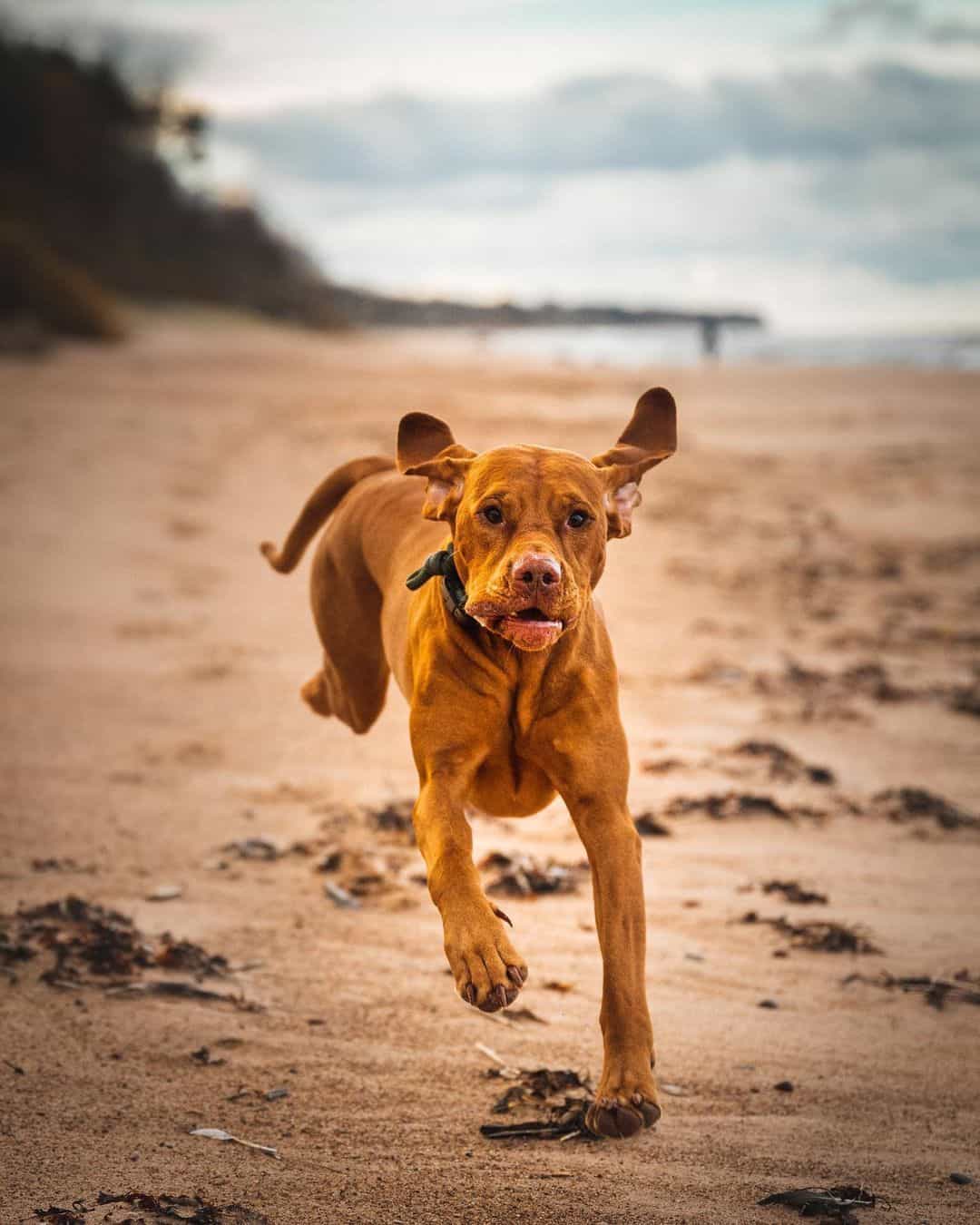The two dog breeds, the Weimaraner and the Vizsla are both excellent in their own right, but do share many similar traits barring coat color to a degree and a few other aspects, but, when looking into the Vizsla vs Weimaraner matchup, which one is the better option for your family?
Whenever the Vizsla vs Weimaraner comparisons start coming in, it’s important to remember that, while they may look identical, there are still a few key differences that separate them aside from being completely different dog breeds.
For instance, the Vizsla hails its origins all the way to the 9th century alongside the first Hungarian settlers, the Magyars, being their loyal companion and hunting dog.
Meanwhile, the Weimaraner is a more recent addition to the doggo roster, bred in Germany in the city of Weimar back in the 19th century to serve as a hunting dog for the German nobility at the time as they were avid sportsmen in regards to hunts.
Regardless, a lot of time has passed since then and dogs have adopted a more domestic role since then seeing how having to scavenge and hunt for our food is something that’s been mostly phased out of the majority of modern society.
In the same vein, hunting for sport isn’t that commonplace among most folk.
So, these hunting dogs have since become used as house pets, their talents adapted to being good companions as well as guard dogs or dogs used in therapy work with a number of patients.
The Hungarian Vizsla was even used in the world war as a messenger, something which has drastically affected its population and had almost ended up making the breed extinct.
However, the question remains, which one is better considering their many qualifications.
That’s what we’re here to find out today as I’ll take each breed and analyze their pros and cons before weighing them against one another to finally announce which of them is a better pick in which areas.
So, read on to find the answer to that as well as the many questions that people often ask regarding these two exceptional dog breeds.
Vizsla Vs Weimaraner: The Rundown
To start things off, we need to see how each dog stands on their own first before pitting their traits against one another. That way we get a clearer picture of each one and can better determine the appeals of each one in a vacuum.
After all, it may just end up swinging the vote for one or the other for you depending on your preferences.
The Hungarian Vizsla

Our first contender is the, ever loved, Vizsla, also known as the Hungarian Pointer, the preferred choice of canine companion for the Magyars of the 9th century, and now, the national dog of Hungary itself due to its many contributions in helping build the country up.
The breed initially arrived in the United States around the 1950s around where it got officially accepted by the AKC.
It’s also one of the first breeds who had won 5 different championships, most of them relating to athletic ability.
Since then, the breed has been rising in popularity in the US and is still on a steady climb to the top, hovering somewhere around the high 20s and 30s in terms of popularity at present.
The Size
Considered to be a medium-sized pointer-retriever dog breed, their average height tends to be around 21 to 24 inches tall at the shoulder and weigh anywhere from 45-ish to around 60 pounds on average, give or take a few depending on variables.
The Temperament
Initially bred to be hunting dogs, the Vizsla has developed a strong bond with their owners, something which has ended up transferring over from generation to generation, making them a great and loyal companion in general.
They’re so attached to their pet parents that they’re dubbed Velcro dogs. It’s also a reason why separation anxiety runs rampant among them when left alone for longer periods of time.
They certainly require a lot of attention, but will definitely return it back tenfold and are great with other family members, especially when properly socialized as they do have a high prey drive which may make it a bit harder to get them to focus.
Thankfully, it’s easily dealt with.
If done properly, it makes them into one of the best family and guard dogs out there.
They’re a high energy breed, one that still has a high degree of trainability as, despite the high prey drive mentioned before, it’s not as dominant as it would be in some other dog breeds like the German Shepherd or Rhodesian Ridgeback.
They’re more akin to Great Danes, slightly imposing, but ultimately gentle and eager to be around others.
The Appearance

The breed is well known for its short coat with a golden-rust color and no undercoat, one of the most clear distinctions between this breed and the German Weimaraner.
Said coat color also pairs well with their lovely brown eyes.
The breed is built to be lean and agile with plenty of stamina due to its upbringing as a hunting dog, making them a great companion for more physically active individuals.
They also have docked tails, a practice that’s a little dated nowadays and cruel considering it serves little purpose in the dog’s uses today and limits the dog’s way of expressing itself all to adhere to the breed standard set by the American Kennel Club.
It was only relevant in earlier times when they were still primarily used for hunting as it allowed them to avoid further injury from game they were hunting by removing the weak spot and preventing it from getting caught in the foliage or similar.
Aside from being more of the athletic type, they’re also pretty fast learners and often seek to be offered mental stimulation as well as physical.
Another distinctive feature are their longer ears which frame their face and give them a very sympathetic appearance overall.
Exercise Needs And Overall Training

The Vizsla, as mentioned already, is an extremely energetic dog who needs a lot of daily exercise.
Walks are fine and all, but, on top of all of that, they also require at least an hour of high-ish intensity exercise.
While it may sound like a lot, this simply translates to either letting them run around freely in a space where that’s possible or to play catch with him or something similar.
As far as behavioral training is concerned, you’ll need to commit to doing it early on so the training sticks better.
Early socialization is key given the breed’s prey drive which, while not as high as the Weim’s is, can still be an issue.
Their clinginess tends to grow to be a real problem too if not curbed through proper training, to the point where other behavioral problems may arise like becoming overly aggressive toward strangers.
The opposite can happen to where he starts creating problems for you if you don’t give him enough attention.
Separation anxiety will kick in for the dog and he may end up feeling sad or depressed and he’ll start to think that you might not care about him, which can then lead to him tearing up the place if left alone for too long, especially if he doesn’t get his walks in.
The training needs to be firm, but fair, one that scolds them for doing something bad and praises them for doing something you deem good and appropriate.
This allows you to cement the foundations of what’s allowed and what isn’t to your Vizsla early on, something he can easily relate to and follow while also helping you assert yourself as the dominant in the relationship.
Dietary Needs
While the required amount of food for a Vizsla is going to vary throughout his life, the average daily food intake for an adult Vizsla is usually somewhere around 3 cups of high quality dry dog food per day.
While you can use human food or wet dog food as a substitute, you’ll be resorting to dry kibble for most of his life as it’s cheaper and more nutritious than other options while also not being as bad for the dog’s teeth as the wet option would be if eaten often.
One more thing worth noting is that given their high energy levels and daily exercise requirements, you’ll want to find food that has a higher protein amount.
Somewhere above 20% should be ideal, give or take a few percent depending on your dog’s habits and activity levels.
To find that out, I suggest seeking advice from a pet nutritionist or your local veterinarian.
Health Issues

While they do have many positives, the Hungarian Vizsla does have a few downsides, most of them mainly related to their overall health which isn’t that great.
The dog’s overall lifespan averages to around 12 years, with the range going from 10, all the way to 14, depending on his general health, diet and lifestyle.
It’s prone to a number of issues, some more common than the other.
First up would be elbow and hip dysplasia, a plague on any senior dog with a little bit of weight to him, or one that’s genetically predisposed to get it, an issue that often causes medium and large dog breeds a great deal of pain and discomfort.
While treatable, it’s a real pain to deal with for your doggo. The best way to avoid it, or to at the very least minimize the chances of it occurring is through proper dieting and exercise to keep your dog in shape.
Going for food rich in calcium and phosphorus does help to a degree too.
Another issue that’s quite common is bloat, one that can affect any dog, but especially medium and large dog breeds, a condition where, due to eating too quickly without properly chewing their food, or some other reason, the stomach ends up distending.
Then, when it has to retract back, it ends up twisting around itself, locking the food, fluid or air up inside the stomach while also cutting off blood flow to the stomach or other organs which can get real bad real fast.
Aside from that, they can also suffer from a persistent right aortic arch and tricuspid valve dysplasia which are issues revolving around the various veins leading to and from the heart, leaving him more prone to heart disease and other heart-related issues.
On top of all that, he may also end up suffering from PRA (progressive retinal atrophy), which, in simpler terms, means that his eyesight can severely deteriorate the older he gets, but can start real early.
Another one related to the eyes, or well, the way visual signals are processed is epilepsy, and we all know how rough that can be for humans, let alone dogs.
Dwarfism is another one which may end up stopping your dog from growing altogether due to hormonal imbalances and other factors, making him look like more of a smaller wiener dog than the full grown Vizsla.
Vizslas are also known to have issues with their thyroid gland, often resulting in hypothyroidism which can also leave them more prone to heart disease.
Finally, the least likely of them all, but still more likely to occur in the Vizsla than a number of other dog breeds is lymphosarcoma, a type of cancer which is, well, terminal if not discovered early.
Other than all of those, the one outside influence that isn’t really reliant on the dog, but rather what they eat, would be worms with the most common types being ringworms, hookworms and tapeworms.
This one is easily avoided as long as you make sure he’s not eating any contaminated food items or other junk.
Whatever the case may be, if you ever see your doggo acting lethargic in any way or seems to show other potential signs of health problems, take him to a vet for a check-up so he can be properly diagnosed and treated if need be.
Grooming Needs
Thankfully, given the dog’s short coat, the Vizsla doesn’t require too much grooming. A brushing session every week or so should be fine to help keep his fur nice and clean and a bath every 6 to 8 weeks, give or take a few days.
The grooming part is the least amount of commitment required compared to exercise and training and shouldn’t impose too much of a problem on your daily life.
Cost
One of the great boons of the Vizsla is the fact that they aren’t all that expensive to get as they aren’t really considered to be the most prestigious of show dogs.
Their prices often range between $500 to $1700, give or take a few bucks depending on the breeder with the average hovering around $1000.
However, you may end up finding them in shelters and rescues for cheaper too, if you ever get the chance to see one, and you’ll also be providing them with a new and loving home.
That said, do keep in mind that this is just the purchase price of the dog itself and that there are plenty of other costs to consider, whether it relates to upkeep costs with food and health or to the price tags on various amounts of dog gear.
The German Weimaraner

Our other contender in the Vizsla Vs Weimaraner square-off is the equally amazing Weimaraner.
The Weim, as previously said, is younger in origin than the Vizsla, only coming in around the 19th century, bred for the nobility of Weimar to serve as a hunting dog in their favorite sport.
Initially made to go after big game, the breed was later utilized to go after smaller game as the breeders came to a realization that they were better suited for such hunts.
They were conceived through an extremely careful breeding process, mixing in several breeds like the blue Great Dane, the German Shorthaired Pointer, the English Pointer, and the Bloodhound, taking the best of their traits to make the Weim.
As to how it came to the US, that happened around the 1920s through a very peculiar way.
Namely, the artist William Wegman used his own Weims in his art and dressed them in human clothing, which ended up becoming quite a hit on our shores and have since been a rising trend.
The breed’s popularity nowadays lies very close to the Vizsla, with only a few spots behind them.
The Size
The Weimaraner comes out to an average height of 24 to around 28 inches in height up to the shoulder for males.
Meanwhile, their female counterparts are a bit smaller with their range coming in at around 22 to 26 inches, give or take a few depending on genes and other factors.
Weight wise, the Weim covers a pretty wide range depending on size going from 55 to 90 pounds, a 35 pound difference which is normally not that common for a medium dog breed, especially when compared to the Hungarian Vizsla.
The Temperament

Once again, the Weim is pretty similar in this aspect to the Hungarian Vizsla, a dog whose loyalty has only grown since his conception and remains strong to this day to every owner lucky enough to have one.
It does swing over to a form of obsession at times, especially if not trained properly, as they too are often labeled as Velcro dogs.
For the Weimaraner in particular, getting their behavioral training and socialization with other dogs and humans early is key as they’re tougher to manage than their competition in this article.
Their prey drive is higher and they always seek to assert their dominance.
That’s why you have to establish yourself as the ‘leader of the pack’ early so he knows to behave.
Said training is also important as it’ll help curb the Weim’s separation anxiety which can get just as bad as the Vizsla’s if not worse if left to his own devices.
That’s because, despite his great desire to be on top, the Weimaraner enjoys the company of others and he tries to make sure that’s always the case.
If he’s not allowed it or is denied it, this will spiral out to misbehaving and various outbursts, be it on you, other people or, most likely, your furniture, slippers or anything else he can get his jaws on.
They’re certainly a bit more of a handful than their competition and are usually only recommended for more experienced dog owners.
That said, they’re still amazing around kids partly because of that clinginess and will make one of the best family dogs if you can handle them properly.
The German Weimaraner is also a high energy dog breed, always eager to go outside and run around and play, anything to be able to expend that energy to feel physically satisfied.
That said, they’re pretty smart dogs too and will seek mental stimulation on top of that which is something else you’ll need to try and provide them with to the best of your ability.
Thankfully, that can all be accomplished through playing with them or by giving them some toys that entertain them through puzzles and such.
The Appearance
The Weimaraner is also known as ‘The Gray Ghost’, both due to its speed and its coat color which ranges from a mouse-gray to a silver-gray.
The coat is short and is paired together with a wonderful set of either amber or bluish gray eyes.
The dog’s ears are longish, about similar in length to that of the Vizsla and give him a wonderful visage.
He has a lean build, a bit less so than the Vizsla, but he’s still pretty muscular and has plenty of stamina to endure long runs given its nature as a hunting dog.
His tail is docked, much like that of his competition here, and for the exact same reasons as a long tail is a liability when hunting wild animals who can go after it and cause unnecessary harm to the dog.
It could also get stuck in branches, holes, bushes and the like, which would either slow the dog down or hurt him, neither of which was ideal.
Nowadays, the practice of tail docking is kept up mostly due to the established breed standard as stated by the American Kennel Club, though you can always ask the breeder if you’re reserving a Weimaraner pup to not dock the tail if you want to.
Exercise Needs And Overall Training

Similar to its competitor, the German Weimaraner is an extremely high energy dog breed who requires a lot of exercise to satisfy his daily physical needs.
The daily amount of exercise is relatively similar too, about an hour of high intensity exercise through either allowing him to run around freely in a secure space or playing physically intensive games with him.
All of this should be done on top of his regular walks.
That’s as far as the physical training is concerned, though he’ll also need to be mentally stimulated to not get bored.
Here, you can get pretty creative though, either by messing around a little during play by hiding the stick or tricking him on when you’re throwing to test his reflexes.
Alternatively, you can opt for a slightly less involved option of getting him some puzzle toys or treat dispensers that he’ll love figuring out to get the prize inside.
This, in part, ties into what his actual training needs to revolve around, and, once again, it’s quite similar to that of the Vizsla, positive reinforcement.
Given their immense levels of loyalty, Weimaraners will be the most receptive to both scolding and praise for when they do something bad, or something good respectively.
It’s important to be firm around your decisions and not give in to the puppy eyes when doing so as it will disrupt the training and his overall thought process which will only confuse him.
I know, it’s a tall order to follow, especially considering some performances that dogs can put on to make you feel guilty, but tough love is necessary at times.
And, once again, it’s best to start him off early as they’re more impressionable the younger they are and the training is more likely to stick than when they get into their more rebellious period.
The high prey drive will be an issue regardless, which is why a firm stance is important and why they’re only recommended to more experienced dog owners who can hold their ground.
If you don’t end up doing that, you’ll only end up with a very unruly dog who will misbehave often and won’t react to your commands as you won’t be considered as an authority above him in his eyes.
The other way the problem can manifest is the whole separation anxiety mess if you end up not having enough time for him.
And, trust me, no amount of training is going to fix that, so you need to know whether or not you’ll be able to avoid that as best you can before opting into getting a Weimaraner.
It doesn’t have to be you, but at least one family member should be around and near the dog at all times to help prevent any destructive behavior.
Dietary Needs

The Weimaraner, given its bigger overall weight, will also require more food than the Vizsla would.
While the exact amount will depend on a variety of factors, some of the most important ones being his age, activity level, and overall size, an average adult Weim will need around 3 and a half cups of high quality dry dog food per day, separated into 2 to 3 portions.
Again, dry dog food is best because it’s better for your dog’s teeth, is more affordable, is cheaper and ultimately more nutritious.
The wet dog food option should be used as a treat every now and then since frequent use would stain his teeth and would overall be bad for them.
Human food is a fine alternative too, but you need to be careful how much you’re feeding him as obesity can be a big problem if left unchecked.
Make sure he always stays within the recommended weight range for his current life stage.
Also remember that due to their high demands for physical exercise, the best food that you can get them would have a relatively high protein content, coming in at around at least 20%-25% or more.
And, if you’re ever confused on what you should be feeding him, seeking advice from a vet or a pet nutritionist is going to be your best bet.
There are plenty of online resources that can help in that regard too if you need a quick reference guide like feeding charts for the respective breed.
Health Issues
While the Weimaraner is usually a healthy breed, they are a bit more prone to a number of health problems that can lead to various problems and difficulties in their day to day lives.
The first and foremost issue is bloat, one that can affect each dog equally, especially ones who haven’t learned to pace themselves while eating or ones who end up physically exerting themselves after a meal.
Both of these issues can cause the stomach to distend and twist around itself, cutting off blood flow to the stomach and a number of other organs, which, if untreated quickly, can even turn fatal, if not already causing major issues.
To prevent this, don’t let your dog do anything extremely physical after a meal and teach him to pace himself while eating and to chew his food. If he doesn’t want to listen, then portion his food out into more servings with less kibble per serving to get him in line.
The other common problem for any medium or large dog breed would be hip and elbow dysplasia, another thing these two breeds share.
These can happen due to age, genes and several other potential factors, but they’re never comfortable to deal with.
However, they’re not fatal nor will they shorten his lifespan, but will need treatment to make the problem less painful and more bearable for your precious pooch.
Entropion is the next issue the Weimaraner has to deal with, one that, once again, isn’t all too fatal, but can be irritating.
It’s when a dog’s eyelid starts growing inward and the eyelashes subsequently end up constantly in contact with the dog’s eye, causing constant irritation and frequent infections.
Thankfully, it’s easy to notice. If you see your dog with a constant red eye, a twitching, teary eye and similar abnormalities, then your dog may be suffering from entropion.
This one, however, can be treated, but only through routine corrective surgery and a brief resting period.
The final issue relates to their thyroid gland, much like that of the Vizsla, hypothyroidism.
It’s a condition where the amount of hormones produced by the thyroid gland are lower than usual, often leading to problems like lethargy, sudden and quick weight gains as well as simply looking weaker.
More apparent signs would be lower fur and skin quality and frequent infections, even some bald spots here and there depending on the severity of the issue.
It’s not a curable problem, sadly, but is easily treatable through oral medication that helps stimulate the production of the necessary hormones.
It may be rough, but it’s the best solution current medicine can offer and it helps him stay as healthy as he can be considering everything.
Lifespan

As far as their life expectancy is concerned, most of them live relatively long lives on average, with 12 being the average that can go all the way up to 15 with some luck and a lot of good nutrition and exercise.
Grooming Needs
With how much of a handful the Weimaraner can be, thankfully his grooming needs aren’t as excessive, allowing you a reprieve in that field at the very least.
Much like the Vizsla, the Weim only needs to be brushed every week or so to help keep his coat straight and prevent matting with the odd bath happening every 6 to 8 weeks or so.
And don’t think the bathing frequency is anything out of the ordinary, dogs don’t really need to be bathed that often as they mostly self clean, and frequent use of shampoos may end up damaging their fur and skin, hence the reason for such seldom baths.
The Cost
While not as cheap as the Vizsla, Weimaraners are still pretty affordable with the minimum price reaching all the way down to $700 with the top end capping out at around $1700 in most breeders, barring a few exceptions.
The average usually comes up to around $1300, give or take a few hundred bucks, but should be around there unless you manage to luck out.
You can even be lucky enough to pick one up at a shelter. They may be a bit tougher to train, but you’ll be making one dog’s whole life a whole lot better if you do so.
Vizsla Vs Weimaraner: The Comparison

With everything properly laid out, it’s time to compare these very similar breeds to determine which one of them is the best dog overall, at least when these two are concerned.
The Price: Vizsla Wins
Starting off with the more obvious parts, the Vizsla is a clear winner in terms of price as both its lower end and its average are lower than the Weimaraner counterpart.
The Temperament: Vizsla Wins
While a close call, the Vizsla ultimately doesn’t have as high of a prey drive as the Weimaraner does which makes it slightly easier to train.
It’s also slightly less aggressive.
While both of them are loving in their own right, ultimately, Weimaraners are a real handful and Vizslas have a lower barrier of entry if you want to raise one as your own.
Exercise Needs And Training: A Tie
Both of them are equally needy when it comes to daily physical exercise as well as mental. While it may seem taxing, it’s ultimately really enjoyable for them and only serves to show their intelligence and their stamina.
Their need for behavioral training and socialization is equal too despite their difference in temperament as they both require a firm hand to roll over and accept you as the new pack leader.
Appearance: Subjective
Both dogs are equally beautiful in their own right, both with their short coats and lovely, but differing colors and striking eyes, with stoic builds that make them appear both fearless and happy at the same time.
The Diet: Vizsla Wins
While their diets are similar in the fact that they both need high amounts of protein, the Weimaraner is ultimately a bigger dog and requires more food overall which will end up costing you more.
This, however, isn’t as big of an indicator of which is better as it heavily leans into the cost aspect that we’ve already covered.
Grooming Needs: A Tie
Both dogs aren’t that demanding in terms of grooming, only needing a weekly brushing and a bath every 6 weeks to 2 months to keep up with their hygiene.
Health Issues: The Weimaraner Wins
Again, a pretty close call here, but the German Weimaraner appears to be healthier than the Vizsla overall with less common health problems, making them easier to handle and less of a financial burden overall.
Vizsla Vs Weimaraner: The Winner Is…

When all is said and done, the overall winner for the average dog owner would be the Vizsla.
Not only do they cost less, but they’re also a lot easier to train compared to the Weimaraner which is more stubborn than the winner in this case.
Sure, they share plenty of similarities, appearance included, but the barrier of entry is a lot more accessible for the Vizsla which allows it to inch out above the Weimaraner as the better option of the two.
Health issues may be a concern, but those can’t be predicted and don’t play as big a part as temperament and ease of training do overall.
That said, they’re both equally great still, and, if you’re a more experienced dog owner who knows how to handle his doggos, then Weimaraners may be your preferred choice as their only real limitation is finding someone who can handle them.
If you can tick that box, this all ends up boiling down to the price and overall health, the latter of which is a bit more important than the former.
FAQs
What Two Breeds Make A Vizsla?
The Vizsla is considered to have originated from the Turkish yellow dog and the Transylvanian hound, the former of which is now, sadly, extinct.
Somewhere down the line, the breed had also added genes from the German Shorthaired Pointer and the English Pointer hence their resemblance to the current iteration of the Weimaraner.
Why Are These Two Breeds So Clingy?
The reason behind it is due to their upbringing. They were bred to be around people during hunts and their loyalty was fostered upon dependence, which, in turn, made these two breeds extremely clingy.
That’s why leaving them alone causes so many issues like separation anxiety and general destructive behavior to grab your attention and why the breeds are only recommended to families who have the time to be around them.
What Are The Main Differences Between A Weimaraner And A Vizsla?
As you may have seen prior, the differences aren’t many, but they do exist.
The first is their coat color with the Vizsla sporting a color more akin to that of golden rust while the Weimaraner has a shade of gray between mouse-gray and silver-gray.
The next difference is in their temperament where the German Weimaraner shows more aggression and a desire to assert dominance than the Hungarian Vizsla does which is more submissive in that regard.
This also means that the latter is easier to train than the former as you don’t need to constantly fight against their high prey drive as compared to the Weimaraner.
In Conclusion
In the Vizsla vs Weimaraner matchup, we’ve noticed just how similar these two breeds are despite being a whole millennia apart in their conception.
While part of that is due to the breeds responsible for their conception being partly similar, the other is due to the purpose of said conception, that of being hunting dogs by nature.
Despite both of them having a prey drive, the Weimaraners being more apparent than the Vizslas, they’re both always deathly loyal to their masters and his family and will always seek their companionship.
This desire to protect and to hang around others is what makes them ideal options to be your next pet, however, it’s clear that they both have their own strengths and weaknesses.
The strengths of the Vizsla are in the ease of training and overall lower price without taking one factor into consideration, one that the Weimaraner is superior in which is a dog’s overall health.
Weimaraners are healthier than their competition in this article for the most part, being less prone to some of the more serious diseases, and would cost less due to a smaller amount of medical bills.
However, what throttles the Weimaraner is their temperament which only more experienced dog owners have a good chance of overcoming to find their diamond in the rough.
However, they’re both fantastic options and whichever one you end up going with, I’m sure it’ll be the right one for you, your family, and your new family member to be. Until next time.
RELATED LINKS:
